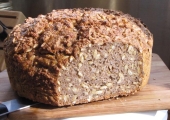We're in Maine and when we bought our land, all the trees in the orchard had severe deer browse damage. We put up 8' fencing around the entire growing area (about half an acre); my husband did the labor along with a local guy who he paid $15/hour and together it cost us ~$4-5K, which wasn't cheap. It could have been cheaper only we used hexmesh wire fencing coated with black vinyl — the effect is that you can hardly see the fence — and he created two fenced-in areas, not one, with a path between them, so we could bring down a wheelbarrow through to another growing area we have beyond. The first winter the fence was up, we got a huge dent in a couple of the fences, as though a doe tried really hard to body-slam her way in sideways and failed. So breaking this grazing habit took a fence that was both sturdy and tall.
This winter we got about 5' of snow and that's the real danger with fencing, that it seems like it's really tall but in the winter when the deer are hungry and you're walking on ice a few feet above the soil, the fence isn't that high at all. However, what mattered is that the fence broke the deer's habit of browsing in our orchard. We have had no problems with deer jumping what is now a low fence. Elsewhere where we planted unprotected apple trees, most of them have been grazed, so the deer are still in the area.
Because we've cut down a copse of pines to make another orchard near those unprotected apple trees, we know we're going to have to fence in that area too. I'm not looking forward to the expense; however, my husband left a ring of pines at the perimeter, and the fence will attach to the pines. This means that the bulk of the work — which is digging the holes and pouring the concrete for the poles — can be skipped. So this fence will be cheaper. If you can leave trees on which to attach your fence, do so.




